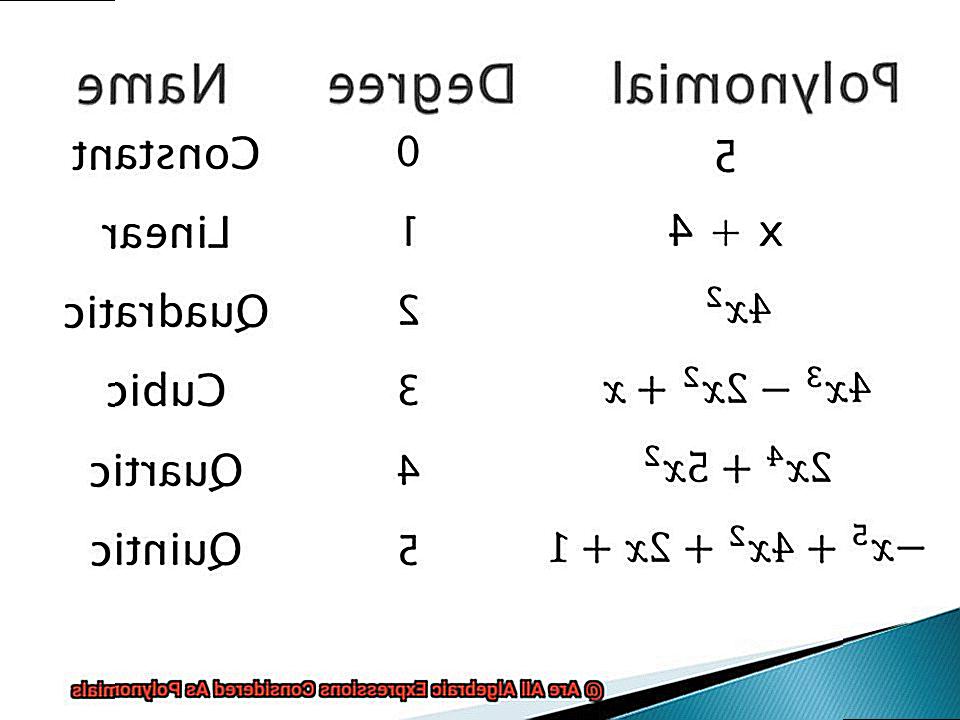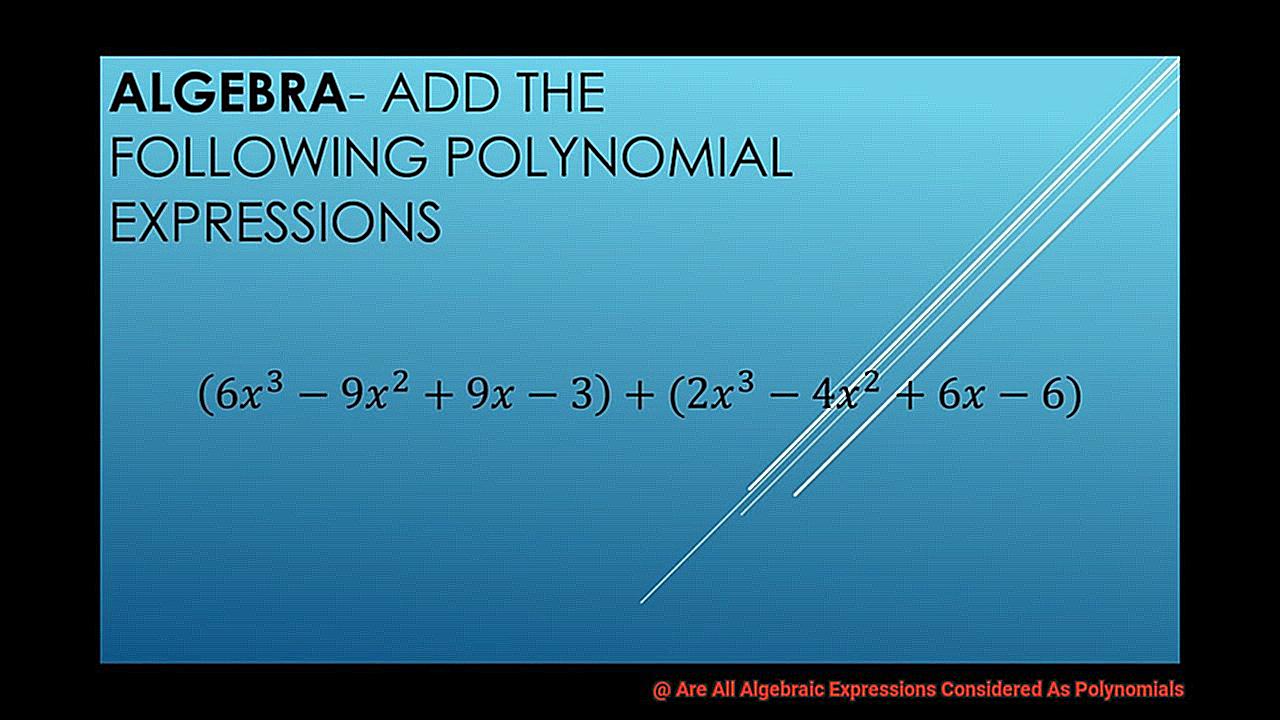
The mere mention of these words may bring back memories of countless math classes and equations that seemed to have no end in sight. But beyond the dreaded textbook problems, algebraic expressions are a powerful tool for understanding and solving mathematical concepts.
And within this realm lies the ever-present question: are all algebraic expressions considered polynomials? Let’s embark on a journey to unravel this mystery and discover the defining features of polynomials.
So, buckle up, because we’re about to dive into the world of polynomials and their place in algebraic expressions.
Are All Algebraic Expressions Considered As Polynomials?
Contents
- 1 Are All Algebraic Expressions Considered As Polynomials?
- 2 Understanding the difference between polynomials and algebraic expressions
- 3 Criteria for classifying an expression as a polynomial
- 4 Examples of polynomials and non-polynomials
- 5 Simplifying and evaluating polynomials vs algebraic expressions
- 6 Real-world applications of polynomials and algebraic expressions
- 7 Choosing the right expression for your mathematical needs
- 8 Conclusion
If you’re someone who has studied algebra, you’ve probably come across the terms “polynomial” and “algebraic expression”. While these terms are often used interchangeably, there are some key differences between them. So, are all algebraic expressions considered as polynomials? In this blog post, we’ll explore these differences and provide a comprehensive explanation of how they are related.
What is a Polynomial?
A polynomial is a mathematical expression that consists of variables, coefficients, and exponents. It can be written in the form of a sum or difference of terms, with each term being separated by an addition or subtraction sign. The following are some examples of polynomials:
- 3x^2 + 5x – 2
- 2a^3 + 4b + 7

As you can see, each term in a polynomial contains a variable with a coefficient and an exponent. Additionally, the exponents must be non-negative integers (0, 1, 2, 3…) and the coefficients must be real numbers.
What is an Algebraic Expression?
An algebraic expression is a mathematical phrase that contains numbers, variables, and operators (such as +, -, x). It may or may not have any exponents or powers. Here are some examples of algebraic expressions:
- 3x + 5
- 2a + b
As you can see, these expressions do not have any exponents. They also do not necessarily have multiple terms like polynomials do.
The Relationship Between Polynomials and Algebraic Expressions
While all polynomials are algebraic expressions, not all algebraic expressions are polynomials. To be considered as a polynomial, an algebraic expression must meet three criteria:

- It must consist of only non-negative integer exponents.
- It must have only one variable.
- It must have finite terms (no infinite series).

For example, the expression 3x + 5 satisfies all three criteria and can be classified as a polynomial. But the expression √x + 5 fails to meet the first criteria (exponent is not a non-negative integer) and therefore cannot be considered as a polynomial.
Why Does It Matter?
You may be wondering why it matters whether an algebraic expression is considered as a polynomial or not. Well, there are a few reasons:
Understanding the difference between polynomials and algebraic expressions
Mathematics can be a daunting subject for many, but by breaking down complex concepts into smaller, more manageable parts, it becomes easier to grasp. One such concept that often causes confusion is the distinction between polynomials and algebraic expressions. While these terms are sometimes used interchangeably, they are not one and the same. In this post, we will dive deep into the world of polynomials and algebraic expressions, unraveling their differences and similarities.
So, what exactly is a polynomial? Simply put, it is an expression that contains one or more terms, where each term consists of a variable raised to a non-negative integer power and multiplied by a coefficient. Let’s break this down further with an example: 3x^2 + 2x + This is a polynomial because it contains three terms (3x^2, 2x, and 5), and each term has a variable (x) raised to a non-negative integer power (2 for the first term and 1 for the second). The coefficients in this polynomial are 3, 2, and 5.
On the other hand, an algebraic expression is a combination of numbers, variables, and mathematical operations such as addition, subtraction, multiplication, and division. Unlike polynomials, algebraic expressions do not have specific criteria for their terms. For example, 4x + 6 is an algebraic expression because it combines numbers (4 and 6) with a variable (x) using addition. Another example would be 2xy + 3x – 7, which combines numbers (2 and 3) with two variables (x and y) using addition and multiplication.
One key difference between polynomials and algebraic expressions is that polynomials can only have addition and multiplication operations, while algebraic expressions can also include subtraction and division. This means that an algebraic expression can be simplified to a polynomial by combining like terms and removing any division or subtraction. For example, the algebraic expression 3xy + 2/3 can be simplified to a polynomial by dividing both terms by 3, resulting in xy + 2/9.
Criteria for classifying an expression as a polynomial
There is something about their organized structure and specific criteria that makes them so appealing to me. But what exactly is a polynomial and how do we differentiate it from other algebraic expressions? Let’s dive in and explore the criteria for determining if an expression is a polynomial.
First and foremost, polynomials must have only non-negative integer exponents. This means that any variables in the expression can only have whole number exponents, such as x^2 or y^This rule may seem simple, but it eliminates many potential expressions from being classified as polynomials.
Another important criterion is the limited operations allowed in polynomials. As we know, polynomials can only have addition, subtraction, and multiplication operations. This means that expressions like (x+2)^2 would be considered polynomials because they only involve these operations. However, expressions like (x+2)/3 or √(x+2) would not be considered polynomials because they involve division and square root operations.
Additionally, all variable terms in a polynomial must be combined using the distributive property. This means that expressions like x^2+2x and 3x^2+4x are both considered polynomials because they follow this rule. However, expressions like x^2+2x+1 and 3x^2+4xy do not follow this rule and therefore would not be classified as polynomials.
One of the defining characteristics of polynomials is that they have a finite number of terms. This means that there cannot be an infinite number of terms in the expression. For example, an expression like x^2+x+x^3+… would not be considered a polynomial because it has an infinite number of terms. This criterion may seem obvious, but it helps us simplify and manipulate expressions to better understand their behavior.
Examples of polynomials and non-polynomials
Have you ever heard of polynomials and wondered what makes them so special? Or perhaps you are familiar with the term but still struggle to differentiate them from other algebraic expressions. Well, you’re in luck. As an expert on the topic, I’m here to guide you through the world of polynomials and non-polynomials. By the end of this post, you’ll have a deeper understanding of these mathematical expressions and their key differences.
So, what exactly is a polynomial? In simple terms, it is an algebraic expression that consists of constants, variables, and exponents, combined using operations such as addition, subtraction, multiplication, and division. Let’s break this down further.
Firstly, polynomials can have one or more terms. A term is a combination of a coefficient (a number) and a variable raised to a power (exponent). For example, in the polynomial 5x² + 3x – 2, there are three terms: 5x², 3x, and -2.
Another important factor to consider is the degree of a polynomial. This is determined by the highest exponent in the expression. For instance, in the polynomial 4x³ + x² – 5x + 1, the degree is 3 because the term with the highest exponent is x³.
Now that we have a basic understanding of polynomials, let’s take a look at some examples. The polynomial 2x + 1 is known as a linear polynomial because it has a degree of 1 and two terms. On the other hand, -7 is a constant polynomial (also called a monomial) with a degree of 0 since it only has one term with no variables.
But not all algebraic expressions are considered polynomials. There are certain criteria that must be met for an expression to be classified as a polynomial. Let’s explore some examples of non-polynomials to better understand these criteria.
One common mistake is to assume that any expression with variables and exponents is a polynomial. However, this is not the case. For instance, the expression 4x² + √x is not considered a polynomial because it contains a radical (√). Polynomials cannot have radicals or fractional exponents.
Simplifying and evaluating polynomials vs algebraic expressions
As an expert in simplifying and evaluating polynomials and algebraic expressions, I am excited to share my knowledge with you on these fundamental concepts in mathematics. These terms are often used interchangeably, but they have distinct differences that are important to understand. In this post, we will explore these differences and why they matter.
Polynomials and Algebraic Expressions: What’s the Difference?
First, let’s define our terms. A polynomial is a mathematical expression that contains variables, coefficients, and exponents, combined using operations such as addition, subtraction, multiplication, and division. It follows a specific format of having one or more terms separated by addition or subtraction signs. On the other hand, an algebraic expression is a mathematical phrase that contains variables, constants, and operations. It can also have one or more terms, but it does not necessarily follow the format of a polynomial.
Simplifying vs. Evaluating
The main difference between simplifying and evaluating polynomials lies in their purpose. Simplifying is used to transform a polynomial into its simplest form for easier manipulation or analysis. This involves combining like terms and following the order of operations to get rid of any parentheses or unnecessary operations. On the other hand, evaluating is used to find the value of a polynomial at a specific point or set of points. This means substituting values for the variables and solving to get a numerical value.
For example, let’s look at the polynomial 2x^2 + 3x + If we want to simplify this polynomial, we would combine like terms (the terms with x^2 and x) to get 2x^2 + 3x + 5 as our simplified form. However, if we want to evaluate this polynomial when x = 2, we would substitute 2 for x and solve to get a value of 19.
Real-world applications of polynomials and algebraic expressions
Polynomials and algebraic expressions may seem like daunting mathematical concepts, but they have a significant impact on our daily lives. From engineering to economics to music, polynomials and algebraic expressions play an essential role in various fields. So, let’s dive into the real-world applications of these powerful mathematical tools.
Engineering Marvels
Engineers rely on polynomials to model physical systems and make predictions about their behavior. In electrical engineering, polynomials are used to analyze circuits and design filters. In mechanical engineering, they are used to model motion and design control systems. Without polynomials, we wouldn’t have the advanced technology and infrastructure that we enjoy today.
Physics Phenomena
The laws of physics can be described using polynomial equations. For example, Newton’s second law of motion can be represented by a second-degree polynomial equation. These equations allow us to understand and predict natural phenomena, such as the path of a projectile or the motion of planets.
Economic Insights
Economists use polynomials to model economic trends and make predictions about markets and consumer behavior. They also come in handy for calculating interest rates and determining optimal investment strategies. In short, polynomials help us better understand the complex world of finance.
Musical Magic
Did you know that polynomials have a role in creating beautiful music? The mathematical relationship between musical notes can be represented by polynomial equations, which help composers create harmony and melody. So, next time you listen to your favorite song, remember that it’s not just art but also mathematics at play.
Everyday Uses
Polynomials and algebraic expressions also have practical applications in our everyday tasks. For instance, we use them to calculate discounts and taxes while shopping or determine mortgage payments. In computer programming, they are used to create algorithms and solve complex problems.
Data Analysis
One of the most significant real-world applications of polynomials is in data analysis. By fitting a polynomial curve to a set of data points, statisticians can make predictions and draw conclusions about the underlying trends in the data. This helps us make informed decisions and solve problems in various fields.
Creating Visuals
Polynomials are also essential in image processing and computer graphics. They are used to represent curves and shapes on a computer screen, allowing for the creation of realistic images and animations. So, the next time you watch a movie or play a video game, remember that polynomials are the backbone of those stunning visuals.
Choosing the right expression for your mathematical needs
We live in a world where mathematics plays a crucial role in our daily lives. From designing buildings to analyzing data, understanding mathematical concepts is essential. And one of the fundamental concepts in mathematics is algebraic expressions. These expressions help us solve problems and make sense of the world around us. However, not all algebraic expressions are created equal, and it is important to know when to use which type of expression.
The most common type of algebraic expression is a polynomial. But what exactly makes a polynomial different from other types of expressions? And why can’t we always use polynomials to solve our mathematical problems?
Let’s start by defining what a polynomial is. A polynomial is an expression consisting of one or more terms, where each term contains variables raised to a non-negative integer power and multiplied by a coefficient. In simpler terms, it is an expression that contains variables, coefficients, and only the operations of addition, subtraction, and multiplication.
However, there are other types of algebraic expressions such as rational expressions, radical expressions, and exponential expressions. These expressions may involve more complex operations such as division, taking roots, or raising to a power. As such, they cannot be considered as polynomials.
So how do we know which type of expression to use? The key lies in understanding the problem we are trying to solve. Polynomials are best used for simple equations involving addition, subtraction, and multiplication. For example, if we need to find the area of a rectangle with sides represented by variables x and y, we can use a polynomial expression like xy.
But what if the problem involves more complex operations? Let’s say we want to find the distance between two points on a coordinate plane using the distance formula. In this case, we would need to use a radical expression instead of a polynomial.
In summary, while polynomials may seem like the go-to expression for all mathematical problems, they are not always the most suitable choice. It is important to understand the differences between polynomials and other types of expressions and use the appropriate one based on the problem at hand.
Conclusion
In conclusion, algebraic expressions may have a notorious reputation in the world of mathematics, but they are actually a powerful and versatile tool for solving complex problems. However, it is important to note that not all algebraic expressions can be classified as polynomials.
While all polynomials fall under the category of algebraic expressions, they possess distinct defining features that set them apart from other types. They consist solely of non-negative integer exponents and involve only addition, subtraction, and multiplication operations, with a finite number of terms. These characteristics make polynomials particularly useful for simplifying and evaluating mathematical equations.
However, in real-world applications and more advanced problem-solving scenarios, other types of algebraic expressions such as rational or radical expressions may be more suitable. It is crucial to understand the differences between these expressions and choose the appropriate one for each mathematical need.
So the next time you encounter an algebraic expression or polynomial in your studies or daily life, remember their unique qualities and how they can aid you in unraveling the complexities of mathematics.


